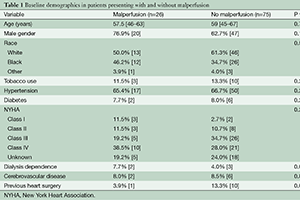Differential outcomes of type A dissection with malperfusion according to affected organ system
Abstract
Background: The management of malperfusion in patients with acute Stanford type A aortic dissection is controversial. We sought to determine the rate of resolution of malperfusion following primary repair of the dissection and to identify anatomic sites of malperfusion that may require additional management.
Methods: We reviewed the hospital records of patients who presented to our institution with acute type A aortic dissection. Patient demographics, operative details and post-operative course were retrospectively extracted from our institutional electronic database. Depending upon the anatomic site, malperfusion was identified by a combination of radiographic and clinical definitions. Data were analyzed using standard univariable and multivariable methods.
Results: Between 1997–2013, 101 patients underwent repair of an acute type A dissection. Thirty-day mortality was 14.9% (15/101); there were five intraoperative deaths. There was no difference in 30-day mortality between patients with or without malperfusion (15.4% vs. 14.7%, P=0.93). Twenty-five patients (24.7%), who survived surgery, presented with 31 sites of malperfusion. Anatomic sites included extremities [14], renal [10], cerebral [5] and intestinal [2]. Of these 31 sites, malperfusion resolved in 18 (58.1%) with primary aortic repair. Renal malperfusion resolved radiographically in 80.0%, with no difference in the incidence of insufficiency (44.0% vs. 35.2%; P=0.44) or dialysis (20.0% vs. 15.5%; P=0.61) between malperfusion and non-malperfusion patients. Extremity malperfusion resolved postoperatively in six out of 14 patients. Of the remaining eight, concomitant revascularization was performed in four, one had an amputation and three required postoperative interventions. Advanced patient age (OR: 1.06, 95% CI: 1.01–1.12, P=0.02) was an independent predictor of 30-day mortality, while preoperative malperfusion was not (OR: 0.77, 95% CI: 0.18–3.31, P=0.73).
Conclusions: Malperfusion complicating acute type A dissection can be managed in many patients by aortic replacement alone with low overall mortality. Most cases of renal and cerebral malperfusion resolved following aortic surgery. Revascularization was frequently necessary in patients with extremity malperfusion. Patients presenting with intestinal ischemia had very poor outcomes. A patient-specific approach is recommended in such complex patients.
Cover






